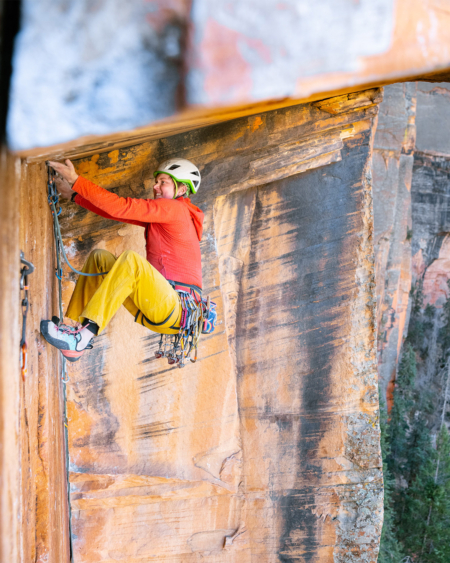Love Scaled Up
Content Warning: This story includes discussions of eating disorders, body dysphoria, self-harm, sexual assault, and suicide. While we have done our best to explore these topics conscientiously, remember that we are looking through the lens of a single person’s experience. Please take care of yourself as you read and use the resources provided at the bottom of this story to find support if you are struggling with any of these topics.
When I survived an overdose at the age of 17, I promised myself that I would never hit rock bottom again. I had seen the pain on my mom’s face, the anger in my sister’s eyes, the fear in my friend’s careful words. I knew I could never put the people I loved through that for a second time. I needed to find a way to feel safe in the world.
As a nonbinary person, I learned at an early age that I was safest when I downplayed my gender identity. If I just didn’t talk about being transgender, and especially avoided the messy parts of my story, I could skate through interactions with a mixture of perfectionism, people-pleasing and well-timed humor that set people at ease. This survival strategy was exhausting and isolating, but I could make it work if I took things one day at a time.
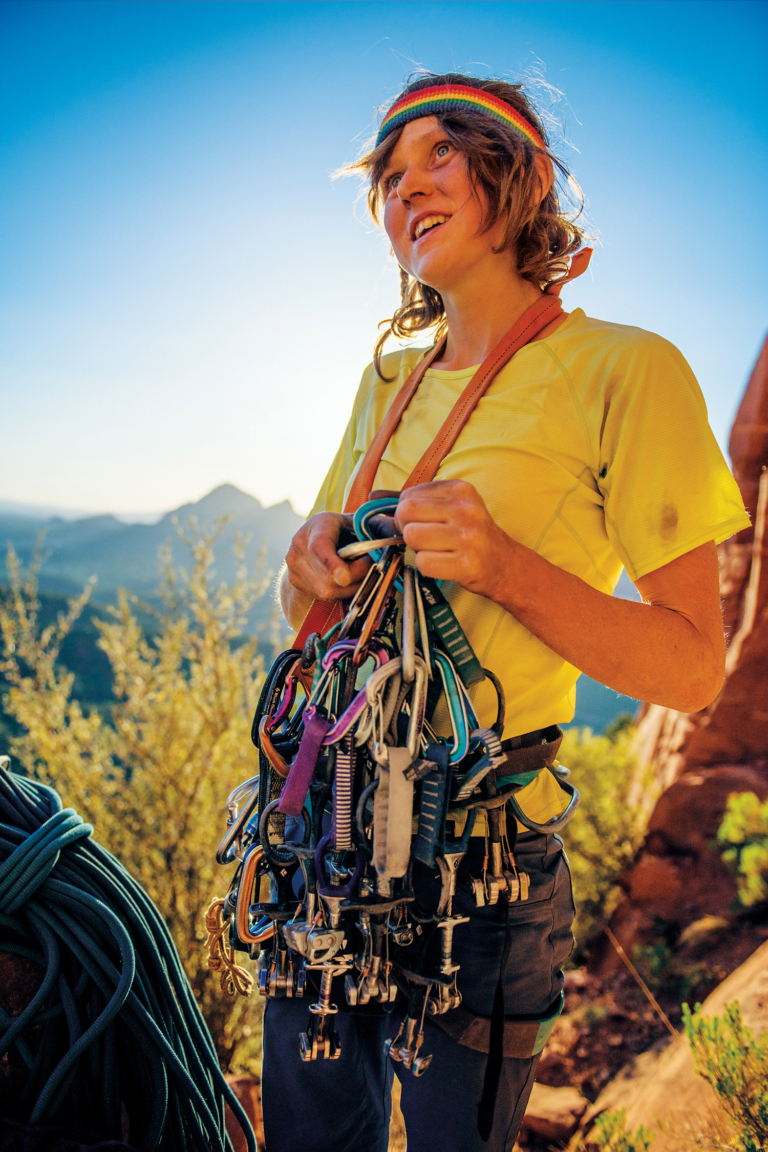
The author in their element—climbing great routes with great friends. Photo: Jeremiah Watt
So, when my friend Blake asked me if I would be interested in making a film about the intersection of my experiences as a trans person and an athlete, I didn’t exactly jump at the opportunity. In fact, if any other filmmaker had proposed the idea, I probably would have said no. I wasn’t out to many people as nonbinary yet, and on top of that, I was still healing from a two-decades-long battle with my body and my relationship to sports.
Blake wasn’t just any filmmaker, though. Blake was a close friend—someone who had shown me countless times that he was on my side. I met Blake during my first week in Flagstaff, Arizona, when my enthusiasm for climbing had finally overridden my fear of meeting new people. Blake was sitting underneath the bouldering cave in the gym, reading a book. I began to walk toward him, got nervous, turned around and then forced myself to walk toward him again. He looked up. “So, uh, do you need someone to belay you?” I asked awkwardly. “No,” he replied. I was mortified. I started to back away. “But I would be happy to climb with you for a bit.”
Blake was one of the strongest climbers in town, but he didn’t make me feel embarrassed or rushed when I struggled on the starts of climbs that night. He introduced me to his friends and made sure that I felt included.
Over the next few years, Blake became the person I saved up funny stories to tell and vented to when I was struggling. His generous laugh and gentle curiosity made sharing feel natural. Eventually, he became one of the few people who I talked with openly about my gender identity. In front of Blake, it didn’t feel dangerous.
I had grown to trust Blake, but this situation felt more committing. I would be sharing my story with Blake, but then it would be shared with a lot more people. “What do you have in mind?” I asked tentatively.
Blake didn’t lay out a storyboard, script or even a loose framework for the story, though. It was obvious he didn’t have a hidden agenda for the project. “It’s your story,” he said. “I’m not interested in writing it. Just helping to tell it.”
I told Blake I would think about it and went home to write down a list of reasons I shouldn’t participate in the film:
- I have spent so many years numbing myself and running away from my identity. That would surely show up in the film.
- I have so much privilege. I’m white and masculine-of-center. Those things make me way less likely to experience violence than a lot of people in the LGBTQIA2S+ community. I want to do more to open the door for the stories of those with experiences that are different than mine.
- I’m not trying to be a professional climber. I have already sacrificed too much to achieve things in sports that I thought would make me more bulletproof. Now, I want to live more authentically and not have to worry about changing my gender presentation to belong.
- I don’t have all the answers about being trans or even what my identity really means.
I looked back at the list. Unknowingly, I had written a list of reasons to say yes.
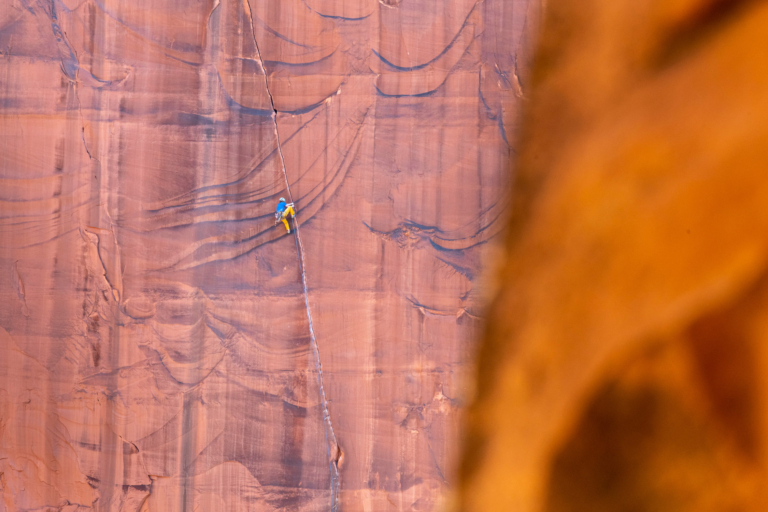
Cruising through a splitter in Moab, Utah. Photo: Blake McCord
An interesting thing happens when you say something out loud that was once shameful. After I called Blake to tell him that I was in, Blake invited his friend Justin to the team, a talented director and storyteller. At the beginning of the filming process, Justin asked me to share my pronouns. I offered an apologetic answer. “I prefer ‘they’ and ‘them,’” I said quietly, “but honestly, I’ll respond to anything. Don’t stress about it. I don’t really care.”
Justin smiled, thanked me for sharing my pronouns with him and told me that he was happy to use “they” and “them.” I had imagined that using gender-neutral pronouns would be too much for others to manage, even when they made my experience so much more comfortable. Justin’s simple gesture was a glimpse into the power of trusting another person enough to be honest about the ways they could support me. I felt my shame dissolve as we moved on to another topic.
Over the next few months, I started experimenting with sharing my pronouns more confidently. Through their willingness to learn, Justin and Blake taught me that it was not my responsibility to downplay my identity for the comfort of others.
As we discussed initial ideas for the story, I began to look forward to the free-form interviews that felt like conversations. During one of my first conversations with Justin, when I shared the story of my suicide attempt, I started to apologize.
“Maybe this is too much,” I started. “I don’t want to just tell another story of a queer person who struggled with their mental health.”
I looked up to see tears welling in Justin’s eyes. “You’re telling the story of being human, Lor,” he said sincerely. “This story is going to be important for a lot of people to hear—not just the queer community.”
Rock climbing is a vulnerable sport. The stress of testing the limits of my physical abilities in a high-risk environment can make it feel impossible to cover up uncomfortable emotions, such as fear or frustration, in the same way that I can off the wall. This is especially true when the route is harder, and the route that I chose to climb in the film, Cousin of Death, felt like an impossible dream for me.
Blake came out to film on my first attempt at the route. Throughout the day, as I managed the jitters of orienting to the exposure and steepness, I felt comforted knowing that my friend was hanging next to me. At first, it was embarrassing to fail repeatedly in front of him. I wanted to look like I knew what I was doing. But Blake made it clear from the start that he wasn’t there to capture my success. He was there to spend time with me on the wall.
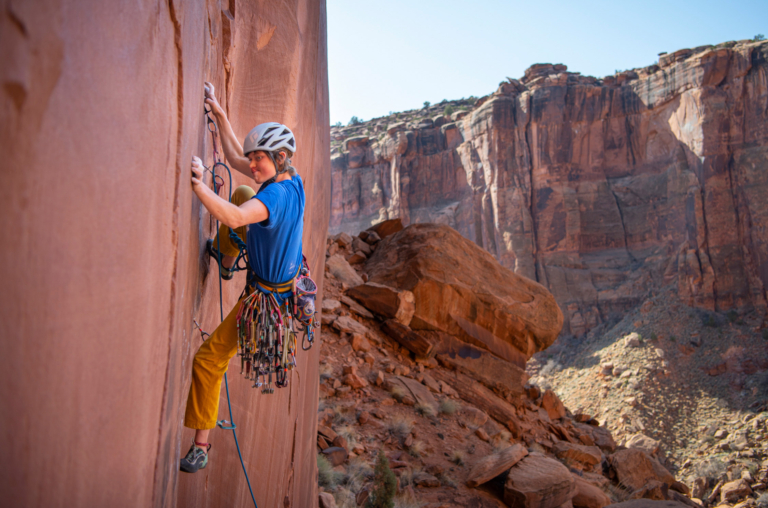
Lor on the thin start of Concepcion near Moab, Utah. Photo: Blake McCord
Because of the committing nature of the route, I worked many of the pitches alone on top-rope solo and recruited partners for specific days when I felt I would be able to link things together for a lead burn. In a way, Blake became my partner for the route. When I was afraid, I would look over to him and we would both giggle. When my foot slipped on an otherwise flawless attempt, he’d share my look of disappointed excitement. Many of the most vulnerable conversations in the film came from candid moments at hanging belays where Blake and I reflected on topics that felt untouchable off the wall.
Blake and Justin became allies in exploring those “untouchable” topics in conversation, like disordered eating and the negative messages about LGBTQIA2S+ folks I had internalized. One day, I confided my anxieties to Blake. “I wish I had things more figured out,” I groaned. “I’m worried that I’m setting a bad example by sharing things like this. I still have bad days.” Blake reminded me that the fact that I still struggled was the reason we are telling the story. “We are telling a story about a human, Lor,” he said kindly, “So there has to be space for you to actually be a human.”
With this newfound freedom to be imperfect, I started to feel more curiosity around my relationship to food and exercise. Thoughts of “I could never eat that” slowly shifted into “I wonder what that would taste like,” and I started to experiment with taking rest days. My body changed, and I became less judgmental toward it. I wasn’t fighting the battle alone anymore.
This expansiveness translated into an open-minded tenacity in my climbing. More than ever before, I felt safe enough to stay in the stress of the unknown. I began to link moves that felt impossible and was less judgmental toward myself when I felt afraid. My impossible project began to feel achievable.
The months and years of filming were transformative for me. As I began to heal, a story naturally unfolded of a person who was growing into their identity. It wasn’t without fear or confusion, but rather with the courage of a person who knows they have a team of people ready to catch them if they fall. Of a person being witnessed with unconditional love. I’m not sure that I would have had the audacity to create a sustainable life—something I was told over and over would never be accessible to me—without the invitation of this film to reflect on what I wanted to pass on to the world.
Shame comes from the seemingly unshakeable belief that if someone really knew who you were, if they knew what you had done, they wouldn’t love you anymore. Blake and Justin created an environment from the beginning that obliterated shame. Neither Blake nor Justin had begun the film with the lived experience of being LGBTQIA2S+ or with a graduate degree in gender studies. Instead, they came with a commitment to tell a story that felt human and authentic without doing harm to their friend. As Blake had promised, they didn’t try to write a story. They were there to listen, reflect and share what they heard.
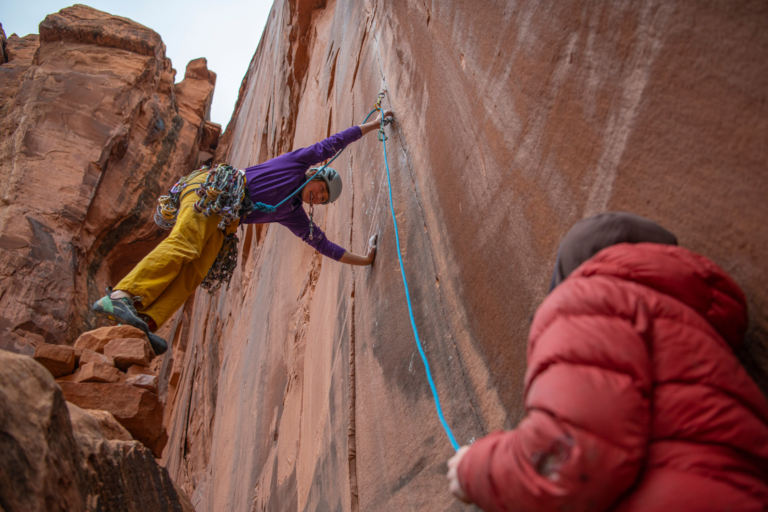
Pulling off the ground on Concepcion. Photo: Blake McCord
So often, we think of “allyship” as memorizing the rule book of dos and don’ts or fighting aggressively for another person’s rights. Education and advocacy are, of course, essential to addressing systemic oppression, but there is another more subtle version of allyship that I learned on this project. It is the ongoing commitment to create a world where the people you love feel safe in their bodies. It is the ongoing commitment to listening, adjusting and checking in with a person to make sure that they know you care.
When I sent in a push from the ground, I was a different climber than I was at the beginning of the season. In the past, I needed to complete big projects to prove to myself that I was worthy of being in the climbing community. I thought my athletic accomplishments could make up for the parts of my identity, like my gender, that felt like they set me at a disadvantage. Now, though, I simply wanted to celebrate the work I had put into the route that season. I was there to climb because it was something I loved to do, and I truly believed that I deserved to feel joy.
This summer, my friend asked me, “How would you tell your story if you truly believed that everyone who heard it already loved you?”
I paused. Her question seemed at odds with my lived experience as a transgender person in a world that debated my right to exist; it was also a description of what I had just done with Justin and Blake.
This film, and the transformations it inspired, took a team of people who were committed to the absolute mess of learning and growing.
While I am, of course, terrified of sharing it with a world that hasn’t proven to me that it will be safe, I am also excited to learn about the capacity for a larger community to join in the conversation. I’m excited to find out if this kind of love and desire to learn can be scaled up.
Watch They/Them and explore ways to defend nonbinary, gender non-conforming and trans people’s rights at patagonia.com/they-them.
If you or a loved one is experiencing a mental health crisis, there are organizations that can help:
The Trevor Project: 1-866-488-7386
Trans Lifeline: 1-877-565-8860
National Suicide Prevention Lifeline: 1-800-273-8255
National Eating Disorders Association Helpline: 1-800-931-2237
